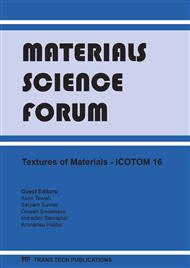p.595
p.599
p.603
p.607
p.611
p.615
p.619
p.623
p.627
Recrystallization Textures in Aluminum Alloys: Experimental Study and Modelling
Abstract:
The changes in crystallographic texture are investigated during recrystallization in 5182 and 6016 aluminum alloys, which were subjected to various cold rolling reductions. In the current study, the texture varieties in the recrystallized materials are conditioned by both the material’s chemistry and the applied rolling strain. The presence of large constituent particles produces strain heterogeneities during cold rolling which causes a specific texture development. The development of recrystallization textures is discussed based on experimental data and results of crystal plasticity simulations. A recrystallization model based on nucleation and growth selection is presented. The driving force for nucleation was accounted for by applying continuum mechanics crystal plasticity models. For the modeling of the strain heterogeneities around hard undeformable particle a FE-code was used.
Info:
Periodical:
Pages:
611-614
Citation:
Online since:
December 2011
Authors:
Keywords:
Price:
Сopyright:
© 2012 Trans Tech Publications Ltd. All Rights Reserved
Share:
Citation:


